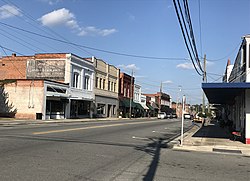2000 census
As of the census [3] of 2000, there were 3,344 people, 1,329 households, and 862 families residing in the town. The population density was 1,299.5 inhabitants per square mile (501.7/km2). There were 1,440 housing units at an average density of 559.6 units per square mile (216.1 units/km2). The racial makeup of the town was 55.65% White, 28.26% African American, 0.06% Native American, 0.24% Asian, 14.06% from other races, and 1.73% from two or more races. Hispanic or Latino of any race were 18.18% of the population.
There were 1,329 households, out of which 28.3% had children under the age of 18 living with them, 44.0% were married couples living together, 15.3% had a female householder with no husband present, and 35.1% were non-families. 31.2% of all households were made up of individuals, and 17.5% had someone living alone who was 65 years of age or older. The average household size was 2.42 and the average family size was 2.96.
In the town, the age distribution of the population shows 23.6% under the age of 18, 8.6% from 18 to 24, 27.0% from 25 to 44, 21.7% from 45 to 64, and 19.1% who were 65 years of age or older. The median age was 38 years. For every 100 females, there were 85.6 males. For every 100 females age 18 and over, there were 81.6 males.
The median income for a household in the town was $25,422, and the median income for a family was $33,413. Males had a median income of $29,226 versus $16,250 for females. The per capita income for the town was $14,380. About 18.8% of families and 23.3% of the population were below the poverty line, including 26.6% of those under age 18 and 26.1% of those age 65 or over.
Population Growth
Mayor Wells called upon Planning Director Rod Fritz to brief the council on rezoning 150 acres south of Wallace in the community of Willard of Pender County. The Planning Board unanimously approved this rezoning request. That area of Willard is now a part of Wallace and the site where hundreds of new homes will be constructed near the exit 390 overpass of Interstate 40. [10]
Council Member Brinkley made a motion to establish a public hearing on March 14, 2024, for the rezoning of property on Hwy 11, that was seconded by Council Member Rivas-Diaz and approved unanimously. That hearing discussed the potential development of hundreds of new homes in the Tin City community of Wallace. [11]
Communities
Tin City
Tin City has a median real estate price is $342,217, more expensive than 60.8% of the neighborhoods in North Carolina and 49.8% of the neighborhoods in the U.S. The average rental price in Tin City is currently $1,073, based on NeighborhoodScout's exclusive analysis. [12] Rents are lower in price than 95.3% of North Carolina neighborhoods. Tin City is a rural neighborhood (based on population density) located in Wallace, North Carolina. Tin City real estate is primarily made up of medium-sized (three or four bedroom) to small (studio to two bedroom) single-family homes and small apartment buildings. Most of the residential real estate is occupied by a mixture of owners and renters. Many of the residences in the Tin City neighborhoods are established but not old, having been built between 1970 and 1999. A number of residences were also built between 1940 and 1969. Home and apartment vacancy rates are 7.2% in Tin City. Neighborhood Scout analysis shows that this rate is lower than 52.8% of the neighborhoods in the nation, approximately near the middle range for vacancies. [13]
River Landing
River Landing is a private community of Wallace. The community mainly consist of retirees. The community has a two 18-hole championship golf courses, clubhouse, pools, expansive homesites, and scenic walking and biking trails. [14]
Northeast
Northeast is home to the Northeast Volunteer Fire Department that provides fire and emergency services to this unincorporated community of Wallace, Duplin County, North Carolina and surrounding rural areas. [15]
Rockfish
Rockfish is a township located in Wallace, Duplin County, North Carolina with a population of 1,667. [16]
Island Creek
Island Creek is a township located in Wallace, Duplin County, North Carolina. [17]
Deep Bottom / Pin Hook
Pinhook/Deep Bottom is a rural neighborhood in Wallace. [18]






